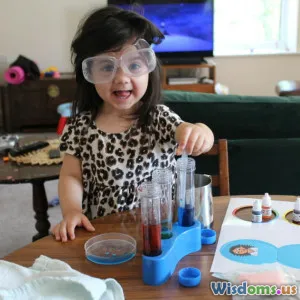
Are Science Kits Worth the Money? A Deep Dive
9 min read Explore the value of science kits: educational benefits, cost analysis, and real-world impact on curious minds. (0 Reviews)
Are Science Kits Worth the Money? A Deep Dive
Introduction
In an age where screen time dominates many children’s daily activities, hands-on learning is becoming more valuable than ever. Science kits have surged in popularity among parents, educators, and hobbyists as a fun, tactile alternative to digital learning. From chemistry sets to robotics kits, these DIY tools promise to spark curiosity, build skills, and inspire the next generation of inventors. But the question remains: are science kits worth the money? This article embarks on a detailed exploration to determine whether investing in science kits truly pays off in terms of educational value, engagement, and cost-effectiveness.
What Makes Science Kits Different from Traditional Learning?
Traditional classroom learning tends to emphasize theory and memorization, often leaving little room for experimentation and creativity. Science kits bridge this gap by offering practical, hands-on experiences that make abstract concepts concrete. For example, kits like Mel Science or Thames & Kosmos provide components to safely perform chemical reactions, build simple machines, or even engage in basic robotics.
Studies show that kinesthetic learning — learning by doing — enhances retention and understanding. According to a 2018 research paper published in the Journal of Educational Psychology, children who engaged in tactile activities related to STEM subjects were 74% more likely to recall concepts compared to those who only experienced passive learning.
This type of active engagement can be crucial in fostering long-term interest, especially in science, technology, engineering, and mathematics (STEM). The hands-on nature makes lessons memorable. For instance, building a mini volcano for a geology kit is far more impactful than reading about volcanic eruptions from a textbook.
Educational Benefits of Science Kits
Building Critical Thinking and Problem-Solving Skills
Science kits encourage experimentation, hypothesis testing, and troubleshooting. When a DIY robotic arm does not function as expected, children learn to analyze problems, break them down, and find solutions — core skills in scientific inquiry and everyday problem solving.
Enhancing STEM Literacy and Inspiration
Globally, STEM careers are growing rapidly; the U.S. Bureau of Labor Statistics predicts a 10.5% growth in STEM jobs by 2032, much faster than the average for all occupations. Early exposure through science kits helps familiarize kids with such careers, reducing the intimidation factor and steering them toward STEM pathways.
Encouraging Independent Learning
Unlike rigid classroom schedules, science kits often come with modular projects, allowing learners to progress at their own pace, fostering autonomy. The Smithsonian Science Education Center highlights that autonomy in learning deepens engagement and motivates students.
Promoting Family Interaction and Social Skills
Many science kits are excellent for group activities, offering opportunities for parents to bond with children while collaboratively solving problems. A 2019 survey by the National Science Foundation found that parents who actively participate in STEM activities with their children enhance their children's academic performance and attitude towards science.
Cost Versus Value: Is It an Investment or an Expense?
Science kits vary widely in price — from $10 for basic chemistry sets to over $200 for advanced robotics kits. A surface-level glance may see them as pricey toys, but a deeper cost-benefit analysis is revealing.
Initial Costs and Reusability
Many kits provide materials sufficient for multiple experiments, extending their lifespan. For example, the KiwiCo subscription boxes offer quarterly science kits that build upon previous lessons, effectively spreading their educational value over time. Additionally, brands like Elenco provide spare parts, meaning kits aren’t single-use.
Compared to Tutors and Classes
Engaging a private tutor for specialized STEM education often costs $50–$100 per hour, quickly surpassing the cost of a well-equipped science kit. For families on a budget, these kits offer a home-based alternative with a hands-on edge.
Potential Hidden Costs
Some kits require supplementary items or consumables (e.g., batteries, chemicals). Transparency about these costs varies, so research upfront is crucial. However, many vendors now clearly list additional needs to avoid surprises.
Long-Term Educational Gains
The real return on investment is intangible yet impactful. According to a report by the Education Development Center, early STEM involvement increases the likelihood of college attendance and degree completion by 24%. Thus, a few science kits could ignite a lifelong passion leading to educational and professional success.
How to Choose the Right Science Kit
To maximize value, consumers should consider several factors:
Age Appropriateness
Kits must be developmentally suitable to prevent frustration or disinterest. For example, National Geographic’s simpler insect and crystal growing kits fit younger kids, whereas Arduino coding kits suit teenagers and adults.
Safety Standards
Especially for kits involving chemicals or electrical components, verification of compliance with safety regulations like ASTM or CPSIA is essential.
Educational Focus and Goals
Some may focus heavily on fun and creativity, like slime-making kits, while others emphasize rigorous STEM instruction, such as advanced robotics kits. Clarifying goals helps narrow choices.
Reviews and Brand Reputation
Trusted brands with positive user reviews often guarantee quality materials, detailed instructions, and improved learning outcomes.
Real-World Insights and Testimonials
Sarah J., a mother of two in Chicago, shares, "When my daughter got her first chemistry kit, she started asking questions about the elements and reactions at school. It boosted her confidence and curiosity. Honestly, it's money well spent."
Mark T., an educator, notes, "Our school integrated DIY kits for after-school programs. Attendance and engagement improved significantly, and we saw better project-based learning outcomes—it’s a tangible difference."
Moreover, the crowdfunding success of companies like MEL Science, which combines virtual reality with physical experiments, underlines a growing market demand and effectiveness in merging they foster deep learning.
Conclusion
Are science kits worth the money? The answer depends on your priorities but leans strongly toward “yes” for those invested in meaningful learning experiences. Beyond the upfront cost, science kits deliver valuable education, improve STEM literacy, nurture critical thinking, and promote lifelong curiosity. When chosen carefully, they are more than just tools; they are gateways to discovery.
For parents looking to inspire and educators seeking engaging resources, science kits represent a cost-effective, impactful investment. Their ability to blend fun with deep learning makes them an indispensable aspect of modern, DIY-enhanced education.
Ultimately, their value is best appreciated not just by what you pay, but by what users gain: sparks of wonder, new skills, and perhaps the seeds of the next great scientific mind.
References
- Journal of Educational Psychology, 2018: Impact of Kinesthetic Learning on STEM Retention.
- U.S. Bureau of Labor Statistics, 2032 STEM job outlook.
- Smithsonian Science Education Center: Advantages of Student Autonomy.
- National Science Foundation, 2019 Survey on Family STEM Interaction.
- Education Development Center: Correlation of Early STEM Involvement to Academic Success.
Explore our recommended science kits and unleash curiosity beyond classrooms.
Rate the Post
User Reviews
Popular Posts





















